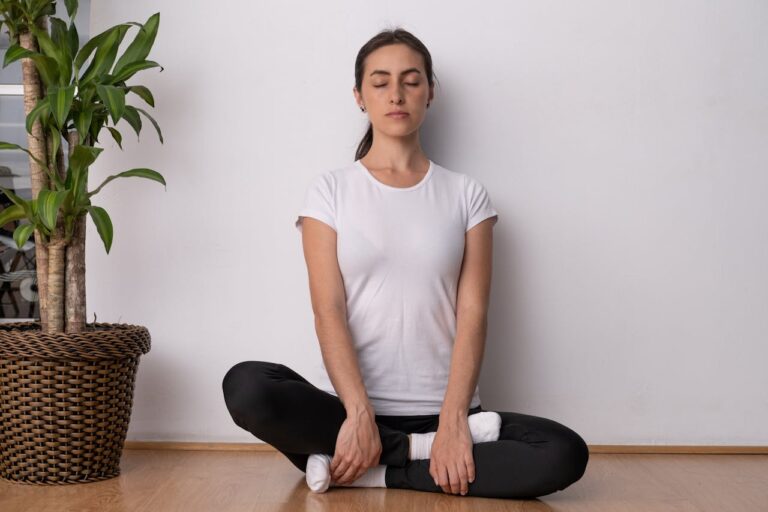How to Unlock the Benefits of Yoga Meditation: Your Easy Guide to Inner Peace

Key Highlights
- Yoga meditation combines physical postures (asanas) with mindfulness techniques for a holistic practice.
- This practice offers numerous benefits, including stress reduction, improved mental health, and increased self-awareness.
- It involves focusing on breathing, incorporating mantras, and practicing mindfulness for a deeper connection with oneself.
- Suitable for all levels, from beginners to experienced yogis, with modifications available for physical limitations.
- Explore different practices like Chakra Meditation and Yoga Nidra for advanced experiences.
Introduction
In a busy world that can make us feel stressed, yoga is a way to relax and find peace inside. Yoga meditation combines physical movements with mindfulness. This helps us gain the benefits of meditation while using our breath and body. By practicing meditation regularly, we start a journey to learn more about ourselves. We can discover more calmness, better health, and greater awareness.
Understanding Yoga Meditation
Yoga meditation is a special practice that sets itself apart from other types of meditation. Many forms focus just on being still and mental exercises. However, yoga meditation includes yoga poses (asanas) and controlled breathing (pranayama). This creates a complete experience. People often call it “moving meditation” because it involves changing between postures while being aware of the breath and body.

In contrast to traditional meditation, yoga meditation usually follows a series of poses. It combines physical practice with moments of stillness. This helps the body relax, and the mind can calm down. As a result, you can experience deep relaxation, clearer thinking, and a strong connection between your body and mind.
The Essence of Yoga Meditation
Yoga meditation is about being mindful. This means paying attention to what is happening right now, without judging it. By focusing on our breathing, feelings in our bodies, and the thoughts that come and go, we become more aware and find inner peace.
The asana practice in yoga helps our bodies be still. By stretching and strengthening our muscles, we let go of tension. This makes it easier for energy to flow. With a relaxed body, we can sit or lie down comfortably for a long time. This helps us relax more deeply and stay focused during meditation.
Pranayama practice is very important in yoga meditation. It affects how we feel mentally. Through breathing techniques, we can calm our nervous system. This helps us lower stress and clear our minds. When we learn to control our breath, we can also control our thoughts and feelings.
Historical Roots and Modern Adaptations
The roots of yoga practice go back thousands of years to ancient India. There, meditation practice was a key part of spiritual traditions. The Sanskrit word for meditation is “dhyana,” which means deep focus and single-pointed concentration.

In yogic philosophy, meditation practice helps people find self-awareness and freedom. With regular effort and steady practice, anyone can rise above the mind’s limits and feel a connection with the divine.
While the core of yoga meditation stays grounded in ancient teachings, modern changes make this practice available to everyone. Today, many styles and methods meet different needs and choices. This makes it easier to add yoga meditation into our daily routines.
The Science Behind Yoga Meditation
Yoga meditation is not just important for its spiritual value. It is getting more attention from scientists too. Studies show that practicing yoga meditation regularly can greatly help our minds and bodies. Research indicates that it can change how our brains work. This change helps us relax more and feel less anxious.
Also, research has shown that yoga meditation can positively affect the nervous system. It activates the parasympathetic nervous system. This activation helps lower blood pressure and heart rate. It also reduces stress hormones like cortisol.
Neurological Benefits of Regular Practice
Regularly practicing yoga meditation provides many brain benefits. Scientific studies using EEG technology show big changes in brain activity during and after meditation. These changes include more alpha and theta waves, which help you relax deeply, lower anxiety, and boost creativity.
Moreover, meditation practice can lower cortisol, known as the “stress hormone.” High cortisol levels can harm the nervous system and weaken the immune system. This can also raise the chance of getting chronic illnesses. By reducing stress and lowering cortisol, yoga meditation supports better health and can help you live longer.
The practice of yoga meditation also boosts neuroplasticity. This is the brain’s ability to create new connections. So, with regular meditation, you can see better memory, improved thinking skills, and a greater ability to learn and adjust.
Impact on Stress and Anxiety Levels
In our busy world, managing stress and anxiety is very important for feeling good. Yoga meditation is a great way to relax and find peace inside.
Doing yoga meditation regularly can lower blood pressure and heart rate. This helps to ease the physical signs of stress. It activates the parasympathetic nervous system, which fights the “fight-or-flight” reaction caused by stress and brings calm.
Also, the mindfulness techniques in yoga meditation help handle anxiety. When you learn to watch your thoughts and feelings without judging them, you grow in self-awareness. This helps you be stronger and deal better with tough situations.
Core Elements of Yoga Meditation
Yoga meditation has several key parts that work together to create a powerful practice. At the heart of it is the breath. Breathing is a great way to connect your body and mind. When we use breathing techniques, we can calm our nervous system, calm our busy thoughts, and find deep inner peace.
Besides breathing, yoga meditation also uses mantras, focus points, and visualizations. Mantras are special sounds or phrases that we can say quietly or out loud to help quiet our minds and reach a meditative state. Focus points, like a candle flame or a picture, give us something to concentrate on. Visualizations help our minds create feelings of peace and calmness.
Breathwork Techniques for Beginners
Pranayama practice is a key part of yoga meditation. It connects the physical side of yoga with the mental side. For beginners, there are simple breathwork techniques that help calm the mind, lower blood pressure, and boost overall health.
One simple technique is diaphragmatic breathing or belly breathing. To do this, sit or lie down comfortably. Place one hand on your stomach and the other on your chest. Inhale slowly through your nose, letting your belly rise. Exhale through your nostrils, pulling your stomach in. Keep breathing this way while focusing on the rise and fall of your belly.
Here are some other easy breathwork techniques:
- Alternate nostril breathing (Nadi Shodhana): In this method, you breathe through one nostril at a time. Use your thumb and ring finger to gently close one nostril. This is thought to balance energy in the body, promoting calmness and clarity.
- Victorious breath (Ujjayi): For this breath, lightly tighten the back of your throat. This creates a soft sound like the ocean as you breathe in and out. Ujjayi breath can help you feel calmer and more grounded.
Incorporating Mantras for Enhanced Focus
Using mantras in meditation can help you focus and feel more connected to the present moment. A mantra is usually a simple word or sound. It serves as a focal point for your mind and helps to reduce constant thoughts and distractions during meditation.
As you say the mantra either in your head or out loud, pay attention to its sound and meaning. The steady repetition can help you control your breathing, making your mind calmer and more focused.
You can use a traditional mantra like “Om” or pick a word or phrase that feels special to you. The important part is to practice mindfulness and purpose. Notice how the mantra makes you feel as you repeat it. Observe how it impacts your body, breathing, and overall mood.
Practical Guide to Starting Yoga Meditation
Starting a yoga meditation journey can change your life for the better. To have success, make sure you create a good space for your practice and stick to a routine.

Keep in mind, consistency is very important to enjoy all the benefits of meditation. Begin with shorter sessions. As you get used to it, you can slowly make the sessions longer.
Selecting the Right Environment
Creating a calm and welcoming space can improve your yoga meditation practice. It helps reduce distractions and encourages relaxation. You don’t need a special meditation room, but find a quiet spot in your home. This way, you can practice without being interrupted.
Think about adding things that bring peace and calm, like soft lights, nice scents, or gentle nature sounds. You might also want to include personal items that are special to you, like candles, crystals, or meaningful quotes.
Whether you like to meditate in the morning to start your day on a good note, or in the evening to let go of stress, the key is to be consistent. Make sure to set aside the same time each day for your meditation practice. It should become an important part of your daily routine.
Establishing a Consistent Routine
When you want to enjoy the amazing benefits of yoga meditation, it is really important to be consistent. Having regular practice helps build discipline. This way, the benefits of mindfulness can touch all parts of your life.
But sometimes, life can be unexpected. It can be hard to keep your strong willpower. If you miss a session, do not be too hard on yourself. Instead, treat your practice with kindness and compassion. Take your time and understand your journey. Celebrate even the small wins and your growth moments.
Keep in mind that each meditation session is a chance to start fresh. Let go of any set expectations. Approach every practice with a curious mind. Be eager to discover what is within you.
Advanced Yoga Meditation Practices
Once you learn the basics of yoga meditation, you can try more advanced practices. This can help you experience even more and understand yourself better. Advanced practices may include special visualizations, energy work, and ways to reach deeper parts of the mind-body connection.
Always be open-minded and curious when practicing these techniques. Remember to respect your body’s limits. It’s also a good idea to ask experienced teachers for help when you need it.
Exploring Chakra Meditation
Chakra meditation is an old practice that helps balance and tune the seven main energy centers in our bodies, called chakras. These chakras are along the spine and connect to different emotions and body functions.
When you do chakra meditation, you focus on each chakra. You visualize its color and element. You can also use special mantras or positive phrases to clear any blockages. This helps energy flow freely in your body.
By balancing your chakras, you can feel more energized, stable in your emotions, and have a stronger sense of well-being.
Integrative Yoga Nidra Sessions
Yoga Nidra, which means “yogic sleep,” is a very restful practice. It helps you relax deeply while staying aware of your surroundings. In a Yoga Nidra session, you will follow guided exercises. These include visualizations, body scans, and breath awareness. This helps your body and mind let go completely.

As you relax deeply, your parasympathetic nervous system comes to life. This triggers many good benefits for your physical and mental health. You may find that stress and anxiety fade away. Your immune system gets stronger, and your body can heal and restore itself.
Doing Yoga Nidra regularly can improve your sleep quality. It can lower stress and anxiety too. Plus, it can boost your creativity and bring you a deep sense of peace and happiness.
Overcoming Common Challenges in Yoga Meditation
Starting a yoga meditation practice is a great journey. Like any new skill, it can have challenges. One big challenge is distractions. These can be thoughts, feelings, or noise around you that distract you from the present moment.
Setbacks happen to everyone when they are learning something new. It’s important to be kind to yourself when this happens. Have patience and try to see the funny side. With regular practice and a willingness to enjoy the journey, you will build the tools and strength to get through these challenges.
Navigating Distractions and Maintaining Concentration
Distractions are a normal part of meditation, especially when you start. The main point is to be aware of these distractions without judging them. If your mind starts to wander, kindly bring it back to your breath or focal point.
Try not to fight your thoughts. Acknowledge distractions when they come up. Then, gently shift your attention back to your breath or main focus.
Think of your thoughts as clouds passing in the sky. Watch them go by without judging them, and let them drift away easily as you focus on the present moment.
Adjusting Practices for Physical Limitations
The great thing about yoga meditation is that it can fit many body types and needs. If you are new to yoga or have some physical limits, you can always find ways to adjust the poses. This helps you feel more at ease. Talk openly with your yoga teacher about any injuries or limits you have.
If sitting for a long time is tough for you, try using cushions, blankets, or blocks for support. If you like lying down better, the Corpse pose (Savasana) is a very relaxing choice for meditation. Always show gratitude in your practice. Celebrate what your body can do and enjoy every step of your journey.
Personal Stories of Transformation
The power of yoga meditation shines through personal tales from people who have felt its deep effects. These stories inspire us. They show that anyone can find themselves through meditation, no matter where they come from or what they believe.
From finding peace during tough times to building more strength and happiness in daily life, these stories show the many ways yoga meditation can help us. By sharing these different views, we want to encourage more people to start their amazing journeys with this age-old practice.
From Stress to Serenity: Real-Life Accounts
In the busy pace of everyday life, it can be hard to find quiet moments. Many people who face stress and anxiety are using yoga meditation to find their inner peace. This practice helps them deal with life’s ups and downs more smoothly.
Through yoga meditation, many have shared amazing stories of change. They have moved from feeling stressed to experiencing calm and clear thoughts. This practice helps create an inner calm that allows worries to fade away. It also opens new ways of looking at things.
These true stories show how important it is to be kind to yourself and to be patient while meditating. Change doesn’t usually happen overnight. Instead, it comes slowly, showing small changes in how we think and our ability to be kind to ourselves and others.
Physical and Mental Rejuvenation Through Practice
Yoga meditation is not just good for your mind; it also helps your body feel better. It connects you to what your body knows. When we move gently, focus on our breath, and pay attention, we start to feel our physical sensations more. This helps us appreciate the miracle of life.
The benefits of yoga go beyond just getting flexible. They support a complete approach to being healthy that helps our mind, body, and spirit. If you practice regularly, you may sleep better, have more energy, and feel more alive.

Additionally, yoga meditation can help with anxiety and depression. It calms the nervous system, improves our mood, and gives us a feeling of peace and happiness. This kind of meditation offers a natural way to boost mental health.
Conclusion
Yoga meditation can change your life. It helps you feel good both physically and mentally. When you understand how it works and the benefits it offers, you start a journey to find inner peace. You might face challenges like being distracted or having physical limits. But these challenges are part of growing. Many people have shared their stories of how yoga meditation has given them calmness and energy. If you stick with this practice regularly, you can find balance in your busy life. As yoga meditation changes with new trends and technology, online options will help even more people find peace and calm.
Discover More About Health & Fitness Tips: Vibrant Fitness
Frequently Asked Questions
What is the Best Time of Day for Yoga Meditation?
The best time to meditate is when you can make it a part of your daily routine. For beginners, mornings and evenings are usually the best times to start a regular practice and feel relaxed. Remember, you can meditate in the present moment whenever you want.
Can Yoga Meditation Improve Sleep Quality?
Yes, regular practice of yoga and meditation can help you sleep better. It reduces stress and helps your body relax. This can calm the nervous system and set you up for a good night’s sleep.
How Long Should a Beginner Meditate?
Beginners can start their meditation practice with only a few minutes. They can slowly add more time as they get comfortable. Try to aim for 5 to 10 minutes at first. Be patient with yourself as you develop a regular practice.
Is Yoga Meditation Safe for Everyone?
While yoga practice is usually safe, it’s a good idea to talk to your healthcare provider if you have any health issues. You can adapt poses for any physical limits you might have. Practicing mindfulness and showing compassion to your body is very important.
How to Incorporate Yoga Meditation into a Busy Lifestyle?
Even a little time spent on regular practice can help. You can fit yoga meditation into your busy life by starting with quick 5-minute sessions. Do these in the morning or evening. Focus on your breath to help manage stress.
The Future of Yoga Meditation
The future of meditation practice looks bright with new technology. This will make meditation easier and more fun. We can expect cool apps, smart devices, and online platforms. These tools will improve the meditation experience and help people on their meditation journey.
Emerging Trends in Practice and Technology
Emerging trends in yoga technology include online platforms that link practitioners from all over the world. They also feature personalized meditation apps and wearable devices. These tools help track progress and improve engagement. All these changes are shaping the way people practice yoga.
Expanding Accessibility Through Virtual Platforms
Virtual platforms have changed how we access things. They provide online classes, guided meditation sessions, and chances to connect with others. This gives people more flexibility. Now, everyone can practice from any place in the world.






